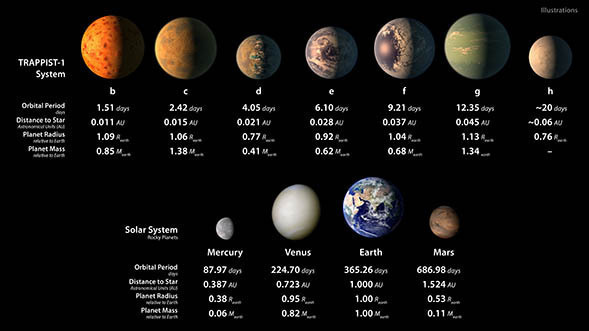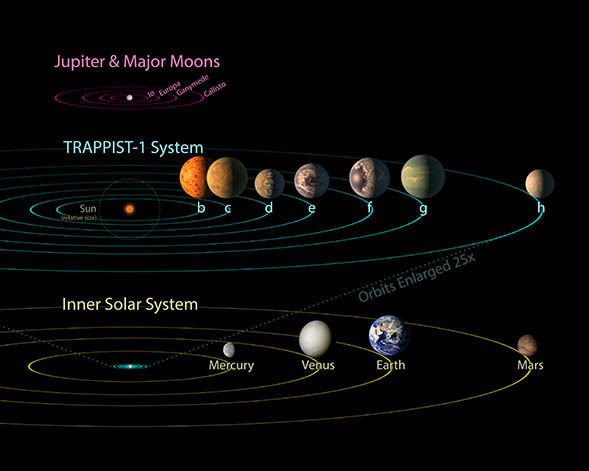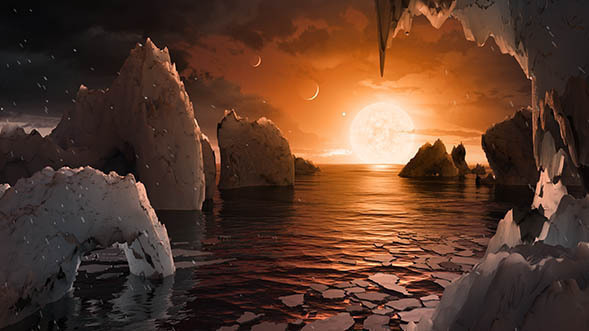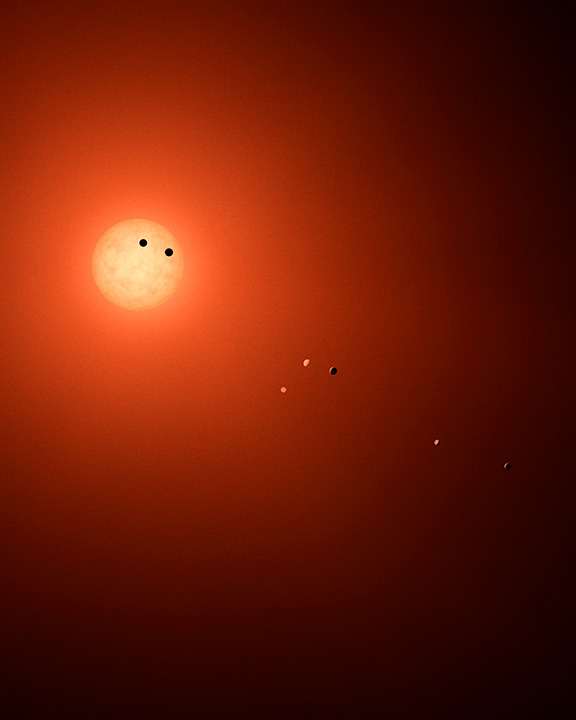In space exploration, there is probably no greater quest than the search for alien life. Our curiosity won't let us rest until we find evidence out there, no matter how wriggly or weird, of living things on another world.
Yesterday afternoon, NASA did NOT announce that it had found alien life. But it did announce the next best thing: planets. And seven of them! All of them rocky and about the size of Earth. All of them with the potential to have liquid water. And to support life.
In a word? Whoa! (We might be really excited right now! Hold tight, this is a doozy of a post!)
Biggest space discovery in years

The seven planets of the Trappist-1 solar system, compared to the four rocky planets of our own solar system. The colours and surfaces of the Trappist system are only an artist's impression. (NASA/JP-Caltech)
The planets orbit a small red dwarf star called Trappist-1. This star is found in the constellation of Aquarius and is about 39 light years (369 trillion km or 229 trillion miles) away from Earth. In outer space terms, that's actually pretty close, though not as close as Proxima B. This recently discovered planet with the potential for liquid water is only 4.25 light years away. But while the remarkable Trappist-1 is about ten times as far away, it boasts a sensational number of planets to study for life. For now, the seven planets are simply named Trappist-1b, Trappist-1c, Trappist-1d, Trappist-1e, Trappist-1f, Trappist-1g, and Trappist-1h.
These seven planets, or exoplanets (because they are outside our solar system), all could have the right conditions for flowing water. This is one of the basic ingredients of life. In particular, planets e, f, g are in their solar system's habitable zone, meaning that they could easily support large oceans, as we have on Earth. So how did so many neighbouring planets have these traits?
Little red
The secret is in the star type of Trappist-1. For starters, it is about the same size as Jupiter. That's huge for a planet, but very small for a star—only about 8% the size of our Sun. That means two things.
Trappist-1 is quite cool for a star—2,288°C (4,150°F) compared to the Sun's 5,538°C (10,000°F). But the planets in orbit around it are also much closer. In fact, a couple of the exoplanets orbit Trappist-1 at about the same distance as Jupiter's moons do. Have a look:

Jupiter and its moons, Trappist-1 and its planets, and our own solar system. (NASA/JP-Caltech)
As you can see, all seven of these exoplanets would fit inside the orbit of Mercury... and still have plenty of room to spare.
Quick, locked orbits with low light
These close orbits mean that a year on one of these Trappist-1 planets would be very short. On planet b, it would last only 1.5 Earth days! (Planet h's year isn't much longer, likely a little over 20 Earth days.) Also, being so close means that the planets are probably tidally locked, which means that the same side of the planet is always facing the Sun (the Moon is tidally locked to Earth, for example). In other words, one side of the planet would always be in daylight, the other side always in night.

An artist's impression of a view from the surface of Trappist-1f. (NASA/JP-Caltech)
But constant daytime and super short years doesn't mean that these planets have regions that are a tropical paradise year round. For one, Trappist-1 is much dimmer than our Sun, too. Though it would appear bigger in the sky, it would only be a few times brighter than a full moon. All around you in the sky, you would see the six neighbouring planets, much as we can see the Moon.
So many questions
If it sounds as though NASA has a lot of stuff figured out about Trappist-1's system, let's be clear: there is so much work left to do. After all, as recently as last summer, the space agency was only able to confirm two planets around Trappist-1 (with a third being suspected). Because the planets are all so close to their star, they can't be observed independently, or on their own. The star's light keeps blinding our view! In fact, NASA could only discover each planet by seeing them when they passed in front of the star and blocked its light coming to Earth. (This neat gif shows how each gap in the light is caused by an exoplanet getting in the way... which happens a lot!)

NASA is now focusing more and different telescopes on the system to learn more about each planet's composition (or the elements that make them up) and atmosphere (such as if they even have one). That last point is very important—without an atmosphere to trap and distribute heat, it is unlikely that temperatures could remain stable enough to support life.
And of course, NASA doesn't know if life is on any of these exoplanets. But the potential is probably the best they yet found. Even better? Red dwarves have a lifespan of 1,000 billion years (our Sun's is about 8 billion). So if life has been living on any of these planets, it is happening in one of the most stable places in the universe.
Visit it now below!
 The discovery of Trappist-1's seven planets was announced Wednesday by NASA. (NASA/Jp-Caltech)
The discovery of Trappist-1's seven planets was announced Wednesday by NASA. (NASA/Jp-Caltech)










So cool!
So awesome!